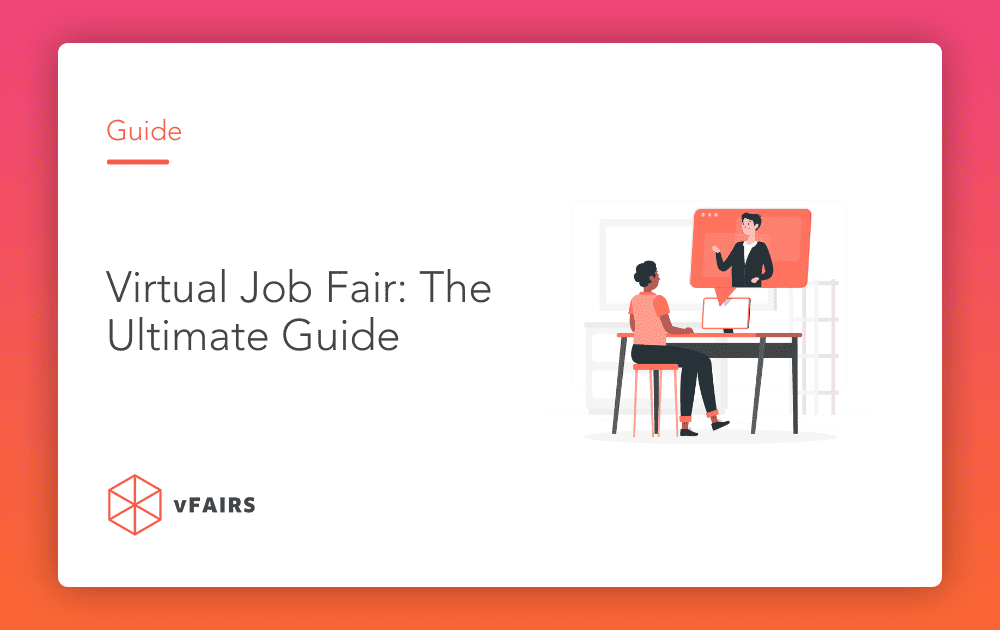Imagine this. An exhibition hall full of multiple companies with individual booths. Candidates swarming the place going from booth to booth, dropping CVs, picking up resources and trying their best to attract attention. Aiming to get the conversation flowing with the booth representative. The whole atmosphere buzzing with excitement. Yes, this is what it was like back in the day before virtual job fair platforms became popular.
Now, in the present, organizations like yourself are virtually recruiting candidates. Even though it was the need of the hour for organizations during COVID-19, it is still here long after the pandemic is over.
Virtual job fairs play a key part in this puzzle. There are undeniable benefits to organizing virtual job fairs — from global reach to increased attendance, reduced costs and much more. A virtual setting allows for features and benefits a physical event just cannot accommodate. Pandemic aside, virtual job fairs are gaining popularity thanks to the evolution of technology and all that it allows us to achieve.
But what are virtual job fairs exactly? How do they work? And how can companies organize them? Hold on. Sit tight. This guide to virtual job fairs is here to answer all your questions and more! Let’s get started.
What is a Virtual Job Fair?
A virtual job fair is just like an in-person job fair, however, it is hosted online. It hosts a number of organizations that have their own individual virtual booths. Virtual job fairs move away from the confines of limited physical space and enter into a space with animated 3D designs, virtual avatars, and the ability to host a huge number of people across the globe.
Virtual job fairs also expedite the entire process of hiring people, enabling organizations to conduct on-the-spot interviews, and finding people most suited for the job by filtering out readily available CVs. They reflect the vibrancy of in-person job fairs, offering organizations and job seekers both an opportunity to connect and network with one another.
Physical Vs. Virtual Job Fair
A physical job fair, as the name implies takes place in a physical location, in a hall, or a hotel. In a physical job fair:
- You set up your own booths, display your own resources and engage in conversation with potential employees.
- People from surrounding areas are in attendance; it is highly localized
- You can only invite a limited number of people due to budget and space issues.
- You will have to incur additional costs associated with food, travel, accommodation, printing resources etc.
A virtual job fair, on the other hand, is arranged in a virtual environment. Your virtual job fair
- Transcends budget and capacity limitations
- Allows organizations to reach a global pool of talent.
- Helps organizations host live webinars, engaging with attendees via live Q&A sessions and polls.
- Facilitates exhibitors in adding and displaying any number of documents and videos to the platform which attendees can download and keep for future reference, without any chance of them losing valuable information.
- Has multiple booths, live chat tools, animated 3D lobbies and interactive designs
Why Should You Host a Virtual Job Fair?
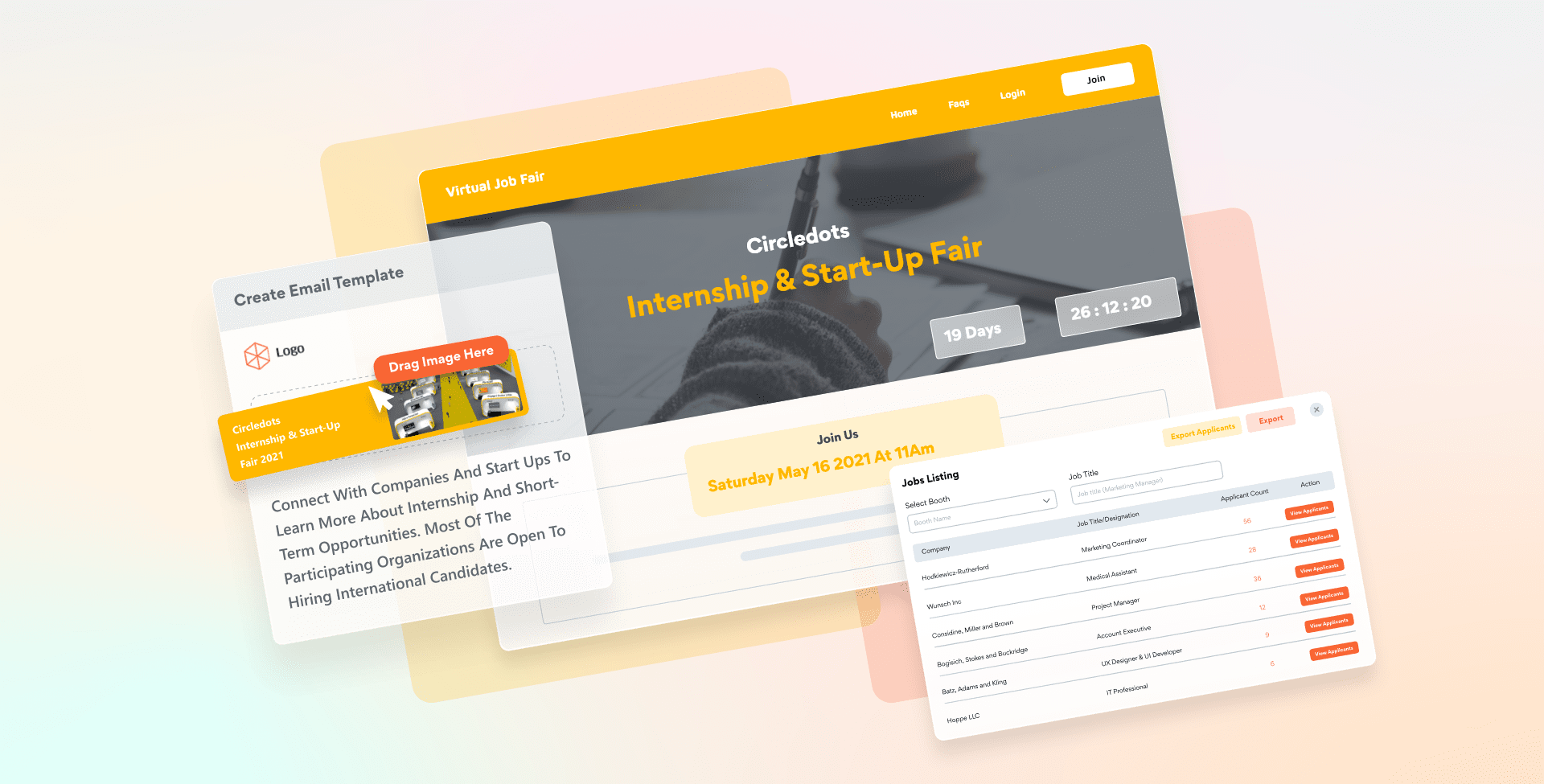
Increased Attendance
With no limitations of physical space and no time restrictions, the virtual job fair opens doors to a wider global audience. Your audience can be in any time zone, and they will not have to miss out on an amazing opportunity. Content and webinars are available after the event ends. Hence, they can access them after the event. This flexibility boosts attendance and reach of the virtual job fair. 34% of planners consider increased attendance the most positive result of pivoting to virtual.
Convenience
A virtual job fair allows for greater accessibility to people who are unable to attend a physical event freely. This allows you to include people with any hearing or visual disabilities who would otherwise be uncomfortable in a physical event. Virtual event platforms also allow accessibility features such as color contrast, event navigation, text size, page narration, webinar translation and captions.
Content
In a physical job fair, you will have to think about printing a bunch of resources, manuals, guides, company handbooks and so much more. There is added cost attached to this. In a virtual job fair, all material plus videos are all available online in the virtual exhibit booth.
Cost
A virtual job fair means all costs pertaining to food, accommodation, travel, venue, chairs and tables, booths etc, have been eliminated. You do not have to worry about putting aside a budget for these expenditures. The exhibitors need not worry about printing costs of resources, standees, and other branding materials.
Minimized Hassle
A virtual job fair reduces the hassle involved in setting up an entire event venue. Traveling long distances, staying in a hotel, traveling to the event venue and then standing in a noisy convention center for hours are equally draining. Plus, you don’t have to worry about tearing down the entire event after it ends.
Reduced Administrative Issues
When it comes to hiring new candidates, sifting through countless resumes and screening candidates is a lot of work. Human resources can save time by virtually recruiting employees. Employers can filter resumes of incoming candidates according to their needs and can easily eliminate the process of interacting with people not suited to the role.
Environmental Friendly
Virtual events are environmentally friendly. Candidates are participating from their own spaces hence, they eliminate the need to arrange for travel, transportation, accommodation and venue. Additionally, they require less paperwork, fewer printed resources, and hence fewer resources are wasted.
Networking
Virtual job fairs don’t take away the opportunity for people to network and build contacts. Your attendees can use the live chat tools to engage with an organization’s booth representatives. They can book a chat slot via the meeting scheduler tool. They can get noticed with live webinars and Q&A sessions. Plus, attendees can even reach out to the booth representatives on their own and initiate conversations.

“I love the fact that people can not only do text chat, but they can also do audio and video chat on the very same platform!”
– Trina Edwards, Director of Operations & Customer Success at Diversity in Ed.
Data Measurement
A huge downside of on-site job fairs is that no one can track attendee movements, or get insights on which part of the job fair was most exciting for them, or where they felt more value. However, a virtual venue gives you valuable data that lets you get an insight into attendee behavior. Your organization can track user journeys and get information on
- How many people visited each booth
- How long attendees stayed in each booth,
- What documents were downloaded,
- Which videos were viewed.
- How many people attended each webinar
- If there were any conversations with the booth representatives or fellow attendees
This allows you and your exhibitors to understand what provided more value to the attendees, and hence can make modifications for future events.
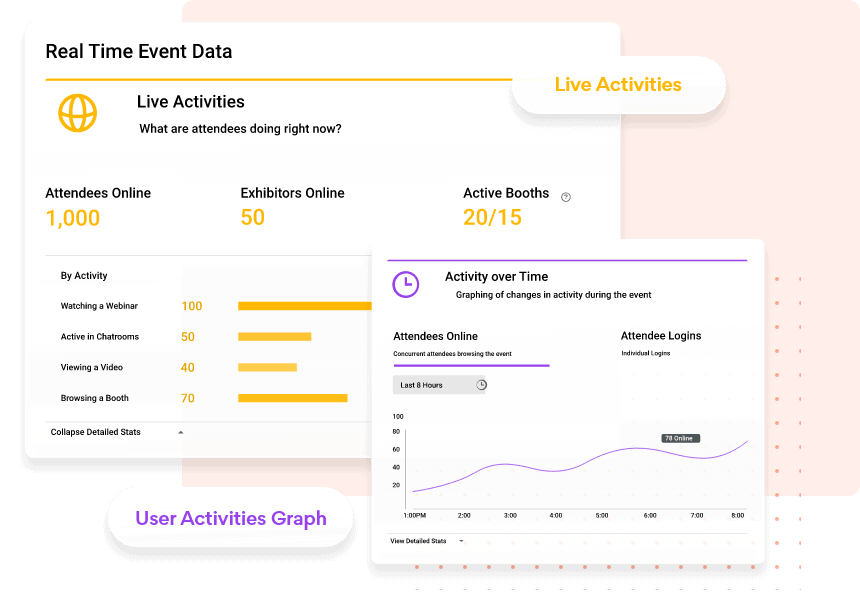
Features to Look For in a Virtual Job Fair
The key features of your virtual job fair platform will define success for you. These features help you stand out from the rest and help attendees and exhibitors breeze through it. Let’s explore these features in greater detail.
Webinars
The virtual event platform allows you to host live, semi-live or pre-recorded webinars. Hosts or employers can conduct these sessions, which is a fantastic opportunity in itself to connect with potential employees. With live Q&A sessions and polls, you can elevate your attendees’ experience beyond just a dull webinar. Employers can take this opportunity to promote their organizational values, company culture and growth opportunities.
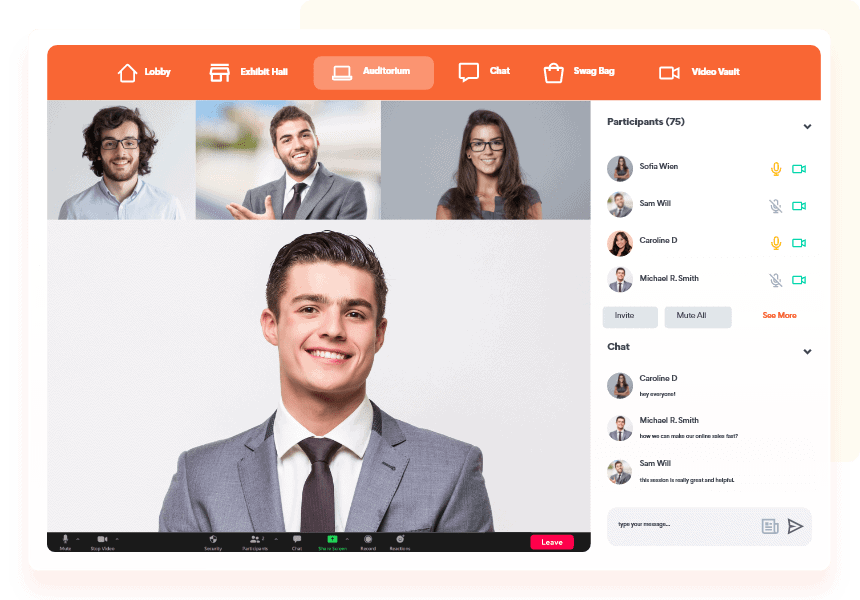
Customized Booths
Your exhibitors can fully customize and brand their booths with their own logos, banners and custom graphics. Additionally, the avatars present in the virtual booths are customizable. This helps organizations present themselves as ethnically diverse to incoming attendees helping them feel comfortable.
Resume Database
Employers can sift through the available resumes to choose the ones most suited to them. They don’t have to spend extra time screening out unqualified candidates. The resume database allows recruiters to filter resumes by city, state, organization, current job title and years of experience.
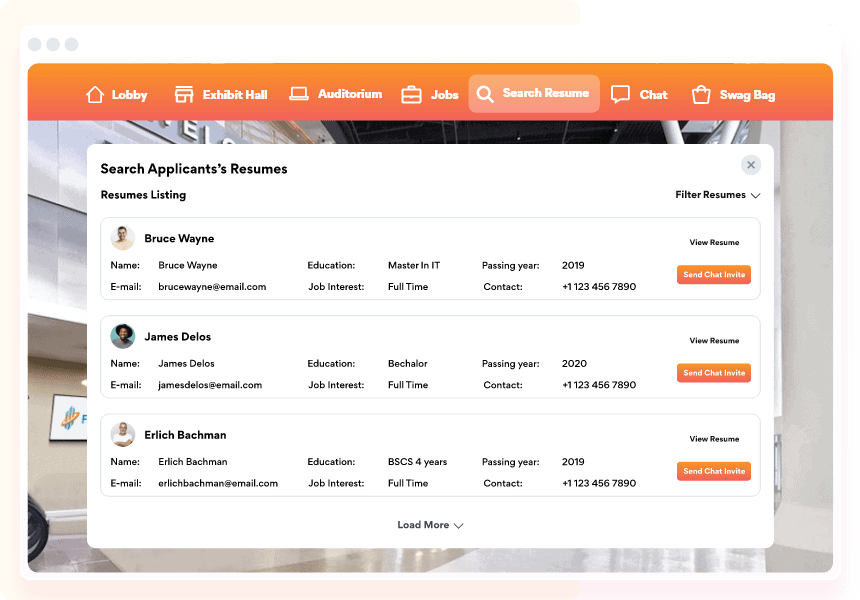
Job Board
For job seekers, the job board is an exceptionally useful tool. It allows
- Candidates to search for open positions and submit resumes
- Employers to list available positions on the job board and collect applications from interested candidates.
- Attendees have access to the job board at any time, filter through the available positions to find the openings most relevant to them.

Event Marketing
What is the use of organizing a stellar virtual job fair when you don’t send out the message loud and clear? You can read this blog for some important tips for making your event marketing campaign more effective.
Automated email builder tools allow you to send customized, timely, and relevant emails to your audience. Send reminders and announcements if audience has
- registered and hasn’t logged in
- logged in and there are some updates
The organizer can also send post-event emails targeting various audience segments. They can send emails to those who
- logged into the event: they will receive an automated thank you message
- registered but didn’t log in: they can get useful resources and takeaways from the event
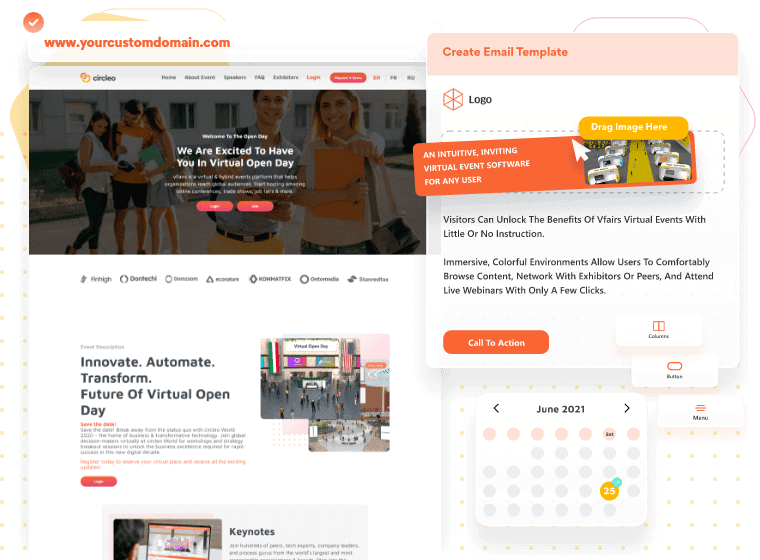
Content
Employers can add relevant content to their booths. These can be videos, documents or other resources. Additionally, photo galleries, presentations and job descriptions etc. can also be easily added.
Job seekers, on the other hand, can easily add these resources, videos and documents alike to a virtual ‘swag bag’ and download them so they can view them at their own convenience.
Data
Detailed live reports and analytics provide insights into the attendee behavior for both the host and exhibitors. With this data you can measure your event’s impact. It allows you to get a clear picture on which aspects of the event were successful, helping you improve future events.
Gamification
To boost attendee participation and interests, you can gamify the virtual job fair. This includes trivia questions, arranging for scavenger hunts that lead attendees across the platform, and leaderboards to incentivize your participants to engage further with the event.

Multilingual Support
Ensure a comfortable environment for your attendees joining in from different countries, speaking different languages. Virtual job fairs that support multilingual support and translations in various languages can create a favorable experience for attendees. Even translations in sign language can help people with a hearing disability easily participate.
Questions to Ask your Virtual Job Fair Provider
Your virtual job fair is there to connect employers with the most qualified candidates. It also aims to provide value to them, cutting their costs incurred and time spent browsing aimlessly through innumerable resumes. So when organizing that virtual job fair, make sure to ask the following questions to your virtual job fair provider. This will keep things clear for you, helping you keep a track of your milestones.
- Do you offer free demos of your events?
- Can you share some samples of past events you’ve hosted?
- How do you manage speaker sessions, networking events and breakout sessions?
- How long does it take to set up the virtual event platform?
- What security features are in place for the virtual aspect of your event?
- Is the virtual job fair platform compatible with multiple devices?
- How do you facilitate interactions between exhibitors and attendees?
- Do you offer any accessibility features?
- What post-event reports do you provide? What are your reporting mechanisms?
- Is there a readily available customer support team?
- What is the most effective way to communicate with your visitors? Is it group chat/conferencing
- What does the design look like?
- How long can the virtual job fair be hosted on one website?
- How flexible is the platform?
“The team was very patient and supportive with us and answered numerous questions along the way.”- Tina Sutch, Event Manager RCNi
How to Host a Virtual Job Fair?
Hosting a virtual job fair requires planning and goal-setting from the very get-go. You need to set milestones in order to deliver your virtual event platform well before time. There is an increase in people recruiting online, and job seekers looking for online avenues. It is better to set a checklist that helps you guide through your planning process.
Here’s a quick checklist to get you started:
- Set your goals for the event, outline key performance indicators (KPIs).
- Choose a virtual event platform provider.
- Identify sponsors and employers that you have to bring on board.
- Outline speaker sessions, create schedules and invite respective speakers for the event.
- Create content for your landing page, exhibitor booths, or any guides, agendas or notes you want the incoming audience to have.
- Actively promote your event on social media channels. Use automated email-building tools to market your event.
- Connect with your virtual platform provider and the project management team to go through the event, test all aspects of the team to ensure there aren’t any last-minute glitches.
- Understand when and how to get reports and analytics for your event.
You can also use our virtual event checklist to help guide you through the process.
Defining your Virtual Job Fair Content Strategy
Content is king, and it binds your platform together.
Without powerful content driving your event, your virtual job fair could fall flat without attracting the relevant audience. Your promotional efforts drive your audiences in, but what keeps them there is valuable information and resources you and your sponsors provide.
But before you start talking about content, answer two critical questions. Who are you talking to? Who is your audience? And what is the objective of this event?
These questions ultimately are the driving force behind your entire content strategy. Additionally, you must also outline your points of contact. These include the
- landing page,
- lobby,
- webinars/ auditorium
- booths and additional content therein,
- Promotion (before, during and after the event)
Once this is sorted, let’s begin with the content planning.
Landing Page
All your promotional efforts on social media, emails and websites bring your audience to the landing page of your event. Make sure you provide relevant and eye-catching information. Apart from the basics, such as the event time, date and details of registration and login, provide details of speakers, organizations coming to the virtual job fair etc.
Lobby
Once your audience enters into the virtual job fair platform, the first place they see is the virtual lobby. With attractive, animated 3D designs and a welcome video, agenda etc., people instantly feel comfortable with the virtual setting. You can also place a guide that attendees can refer to when navigating through the platform.
Webinars
Webinars conducted by either employers, sponsors or industry experts, must provide valuable information to job seekers. Employers and sponsors can use these webinars to deliver information on company culture, jobs and vacancies. Industry experts can share their stories and advice about their own career journeys. This is a great way to build your employer brand and offer value to attendees.
Exhibitor Booths
Virtual booths are the perfect place to form a connection with visitors. Offer content that appeals to your audience. For instance, employee testimonials, or checklists of documents required or even guides.
Ask yourself one question: how is this piece of information adding value for my attendees? You can feature videos on employees or show them around the office space. You can even have your CEO talk about the company, its goals and where they see themselves in a few years. Moreover, job seekers are interested in understanding how they can grow as professionals within the organization, so make sure to cover that in your content.
Promotion
When creating content to promote your virtual job fair via social media channels and email marketing, keep your target audience in mind. Understand what they would want to know about your event. What would they be interested in? Include:
- Speakers and speaker sessions
- Sponsors and exhibitors
- Topics of interest
Aggressively promote your event via social media, PR channels, email marketing, webcasts, webinars and more. 37% of event planners report that social media exposure is a key metric of event success.
How Much Does a Virtual Job Fair Cost?
Setting up a virtual event is easier on the pocket when compared to setting up a huge physical event. Moreover, the virtual event is scalable, so you can invite as many people as you like, with the cost not skyrocketing all of a sudden. The few considerations that have to be taken into account are:
- Virtual event platform provider fee
- Content production (videos, documents and other resources)
- Third-party integrations
The base cost of a virtual event is almost $20,000 less than the average cost of an in-person event, pre-COVID-19. Depending on the sponsorship pricing you offer to employers, it’s easy to see how quickly you can recoup that investment and even end up profiting!
Your Virtual Job Fair: Key Takeaways
Virtual recruitment looks like it’s here to stay. As employees are working remotely, and universities are conducting virtual classes, the chances of in-person job fairs in the near future is highly unlikely. An increasing number of organizations will now be hosting virtual job fairs beyond the COVID-19 pandemic.
Here’s a recap of a few things you must remember from your guide to virtual job fairs:
- Virtual job fairs increase attendance bringing a global pool of candidates to your organization
- They offer convenience for both employers and job seekers via job boards and resume filter features of the virtual platform
- Put together a rock-solid content strategy for your virtual job fair platform
- Measure data in real-time and analyze attendee behavior
- Ask questions, get a complete understanding of the platform from your virtual event provider
- Set realistic and achievable milestones in your journey to setting up your virtual platform and hosting your event
Aviation job search broke through the traditional job market with high levels of candidate engagement. They attracted over 3400 registrations with almost 1000 job applications. This is the far reach and impact that a virtual job fair allows.
